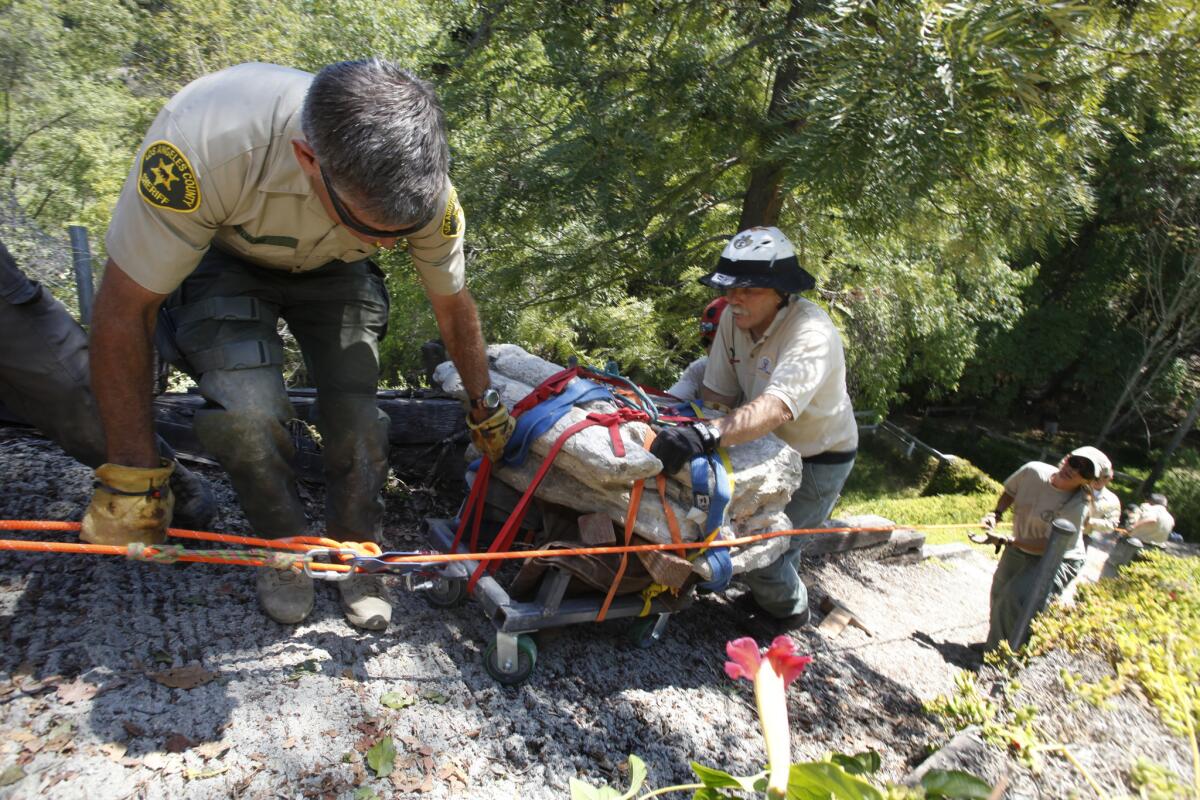16-million-year-old whale fossil ‘rescued’ from hillside

- Share via
Negotiating a system of ropes and pulleys, a search-and-rescue crew labored for hours Friday through dirt and tilted terrain to free a trapped whale fossil from a Rancho Palos Verdes hillside.
The approximately 16-million-year-old baleen whale fossil at the heart of the hubbub that prompted a caravan of news crews to quiet Browndeer Lane was stoic and unmoving throughout the four-hour ordeal.
“This victim was very compliant,” said search and rescue Reserve Chief Mike Leum after the rescue.
Fragments of the whale’s jaw, skull and baleen were fossilized in a more than 1,000-pound rock, which rested at the base of an incline on a narrow, gravel and dirt trail situated on a hillside behind two homes.
Location and size complicated excavation efforts, but the rarity of the fossilized baleen whale, thought to be one of about 20 in existence, was enough for officials at the Natural History Museum of Los Angeles to team up with the L.A. County Sheriff’s Department’s Search and Rescue.
Baleen, which functions as a filter for toothless whales during feeding, is composed of a soft tissue, fingernail-like material, making it difficult to fossilize, said Howell Thomas, a senior paleontological preparator at the museum.
“Baleen whales don’t just grab fish individually – they actually open their mouth and they suck in a lot of small animals,” he said. “That actually gives them the capacity to grow large because they’re eating a large quantity of small animals at one time. They’re filter-feeders.”
Thomas was contacted a few months ago by Gary Johnson, whose parents own one of the homes at the top of the hill. Johnson happened on the fossil as a “nerdy” 17-year-old in the summer of 1978 as he walked the trail in search of natural artifacts.
Noticing the striations on the rock, Johnson contacted a museum that year and was told the fossil was of a whale millions of years old. The museum did not have the resources to extract the rock at the time.
Johnson and a few friends had placed the rock on log rollers and, over the course of days and feet at a time, moved it over to the base of the incline -- just off a steep staircase leading to his parents’backyard.
And there it rested, largely undisturbed, for 35 years.
In February, Johnson’s archaeological spirits were kindled once more when an unrelated rare whale fossil discovery was made on the other side of the hill at Chadwick School.
He contacted Thomas and realized, then, how rare his fossil was.
The months since have been devoted to ironing out the logistics (airlifting the rock by helicopter would have been too expensive, Johnson discovered) and coordinating with Montrose Search and Rescue.
Finally, on Friday about 9:30 a.m., a 10-member volunteer crew typically dispatched for recovery operations on 500 square miles along the Angeles Crest Highway, began preparing for a recovery unlike any other.
Rescuers dug with crowbars and plied their gloved hands into the dirt, eventually loosening the partially buried rock from the earth. They then used straps to harness the hefty stone, clipping the harness to a metal tripod capable of hoisting more than 5,000 pounds.
A rescuer cranked the tripod--which Leum said has been used to lower rescuers into mine shafts--until the rock was a few feet off the ground and capable of being lowered onto a small cart designed specifically for the occasion.
Nestled on the cart for the ride, the fossil was heaved and hoisted incrementally by rescuers using a ropes-and-pulley strategy up an estimated 25-degree incline.
The cart rounded a bend in the path, made its way up a shorter incline into a backyard. It was rolled and carted to the front lawn, where it was lifted on a truck and hauled away to the Natural History Museum, where it was donated for research.
Johnson looked on Friday, snapping photos of the excavation and talking with reporters as neighbors and curious children peaked in. For the 53-year-old, the 16-million-year-old fossil had been a part of most of his life, at least peripherally.
He said, “It’s like a snapshot of my childhood.”
For breaking news in Los Angeles and the Southland, follow @debbietruong or email her at debbie.truong@latimes.com.
More to Read
Sign up for Essential California
The most important California stories and recommendations in your inbox every morning.
You may occasionally receive promotional content from the Los Angeles Times.













